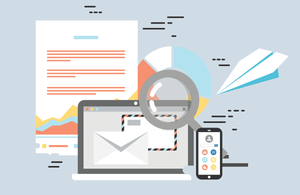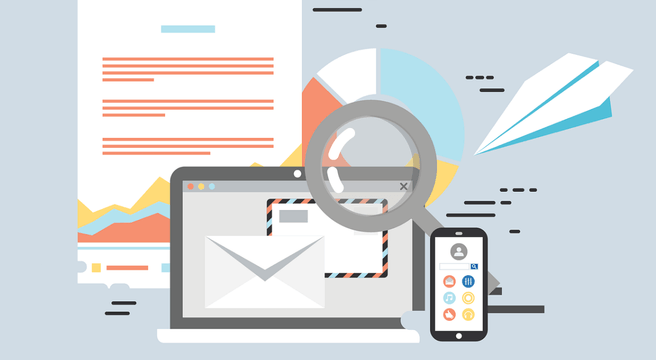Email marketing can help you stay in touch with customers, build trust and increase sales. But first, you need a list of people who are willing to read your emails. In this beginners guide to email list building, we look at how you can start an email list from scratch.

Why Build an Email List?
According to statistics collected by HubSpot, “Email marketing has the highest return on investment for small businesses.”
Emails remind customers that you are there for them. Providing your customers with helpful and engaging content (straight to their inbox) will help build trust in your brand, making your customers more likely to buy from you further down the line.
Which brings me to my first tip towards building your email list:
Provide Value
People are not generally keen on signing up for more marketing junk emails. Therefore you need to offer them an incentive in the form of something useful or entertaining. What will provide value to your customer?
Examples could include an informative and engaging newsletter, a free download such as an eBook, a competition, or a special offer.
Just remember not to give the hard sell in every email. The priority of your emails should be to provide something of value to your customers.
Let People Know Why They Should Sign Up
You’ve created some valuable content. Now tell people why they should sign up for it by showing them the benefits they will gain. Are you offering tips, industry insights, funny stories? Let them know why your newsletter is for them.
Write Compelling Calls to Action
You have shown people why they need to sign up for your email list. Now seal the deal with a motivating call to action (CTA), which tells people what to do next.
You can write CTAs on your home page, landing pages, sign up forms, at the bottom of blog posts and any other pages on your website (make sure they are relevant to the page and don’t go overboard).
The language you use in your CTAs is important, and there are many strategies you can use (too many to go into here, so here is a handy article on Six Ways to Craft a Great Call to Action). As a rule of thumb, keep CTAs concise and focus on how signing up benefits the customer. For example, Grab your free guide or Activate your 20% discount.
A good way of finding out what works best is to test different CTAs on your website. Which ones encourage the most action?
Create Landing Pages and Sign-up Forms
People need a way to sign up to your email list. You can do this by including sign-up forms, CTAs with buttons, and dedicated landing pages on your website.
Landing pages (dedicated pages about your offer or resource) are great for giving people more information (and providing more opportunities to persuade people how great it will be to sign up).
Additionally, providing a link to a dedicated web page helps point people to where they need to go to sign up. If you just gave them a link to your homepage, they might get lost trying to find what they were looking for (i.e. your spectacular offer or resource).
Sign-up forms can be added across various pages on your website and act as a gentle nudge for people to sign up for more good stuff from you. You can add them to your Home page, About page or even at the bottom of your blog posts.
Whether you create a dedicated landing page, sign-up forms or buttons (or all three), remember to make them stand out with engaging design and copy (text) that communicates the benefits of signing up to your email list.
Promote Your Stuff
You now have some helpful content to share, and you have made signing up a breeze. The problem is, people aren’t going to turn up if they don’t know about it. It’s now time to start promoting your stuff and building that all-important email list.
Places you can promote your newsletter, link to a landing page, etc. include:
- Social media
- Your blog
- Your email signature
- On your website (e.g. your home page or about page)
How to Build Your First Email List
Start with your existing contacts
Your existing contacts are an easy place to start. However, don’t just add them to your list and start sending them emails. (You might lose a few friends overnight!) Instead, get in touch to let them know that you are starting a newsletter (etc.) about X, Y, Z and ask them if they would be interested. If they are not interested, don’t include them.
GDPR (the European data protection law) requires that you obtain permission before adding people to your mailing list, so remember to always ask first, whether you know the person or not. It should also be easy for them to unsubscribe at any time, for example, by adding an unsubscribe link in the footer of your newsletter.
Social Media
Let your social media followers know about your content or offer and link to places they can find out more or sign up. You can even post a link to your newsletter directly into a post. Some groups on social media let businesses promote their content, products or services – have a look to see if there are any in your industry.
Blog
Blog posts can be a great place to invite people to join your mailing list. After enjoying your blog, they may well want to sign up for more content from you.
Add a sign-up form or build in a CTA at the end of your blog post. For example: “Do you want to learn more about X, Y, Z? Then join our other subscribers and get tips and tricks sent directly to your inbox”.
Ads
Ads provide a great way to let people know about your business and can be used to kick-start your list building. Different places you can advertise online include search engines (Pay Per Click), social media (e.g. Facebook or Instagram), and display advertising (i.e. eye-catching banners on websites).
There are many options and platforms to consider, which can sometimes make online advertising a complicated and time-consuming endeavour. One solution is to use a multi-channel service that helps you to advertise across different platforms from one place, such as Smart Performance by Yell.
Best Practices for Email Marketing
As with anything, there are best practices to follow when sending out emails. You can read more about them in our article, 11 Awesome Email Marketing Best Practices






